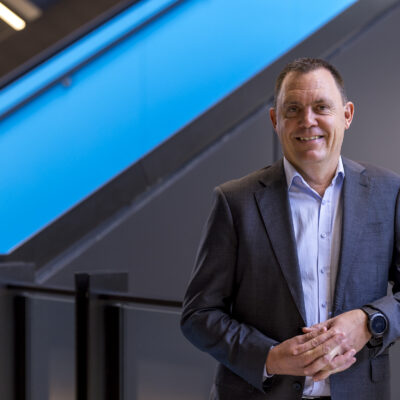Pictured above: Mark Callander.
Following the release of the 2025 Shaping Business Survey by 2degrees, which revealed a surge in business optimism among Kiwi SMEs, NZBusiness sat down with CEO Mark Callander to unpack the findings and discuss how small businesses can turn sentiment into success – even amid rising costs and cautious consumers.
The 2025 edition of the survey reveals a surge in business confidence across New Zealand, with 45 percent of business leaders feeling more optimistic than in 2024, the highest level recorded since the study began. Sixty-five percent expect revenue growth in the year ahead, while 46 percent report increased productivity, largely driven by the adoption of AI and digital tools. Notably, SMEs are shifting their focus from hiring to leveraging technology, with 59 percent identifying AI as a key productivity driver. Despite this optimism, cost pressures remain a concern, with nearly 80 percent of businesses experiencing rising operating costs and around half planning price increases in the next 12 months.
Q: The survey shows rising business optimism, yet cost pressures remain high. How do you see businesses balancing growth ambitions with cautious consumer behaviour?
Mark Callander: It’s a real balancing act. But businesses with a clear growth strategy and the agility to execute it stand to gain a competitive edge. Many are also looking inward to drive efficiencies in non-core areas, freeing up resources to reinvest in growth. The current environment rewards those who are bold and forward-looking, while still maintaining financial discipline.
Q: With productivity gains increasingly linked to technology rather than talent acquisition, how can SMEs with tighter budgets realistically adopt and benefit from AI and automation?
MC: AI is becoming more accessible and affordable than many other forms of technology. It’s no longer reserved for large enterprises – many platforms used by SMEs are already starting to embed AI capabilities as standard features. For small businesses, this may be using tools such as Copilot through Microsoft or ChatGPT for time-consuming but low-value tasks.
The key is to be curious, learn from others, and start small. People will be amazed at how easy some things are – even something like building a website. SMEs should lean on vendor solutions and seek partners who are integrating AI into their offerings. It’s worth asking your suppliers, “What are you doing with AI, and how can you help us?”
Q: Flexible working and training were popular retention tools in your findings. What else can SMEs do to keep talent engaged without increasing overheads?
MC: Flexibility is key, especially in a post-COVID world where work-life balance is highly valued. SMEs can compete by offering hybrid or remote work options – which may also reduce the need for office space. Other cost-effective options include mentorship programmes, peer learning, and fostering a purpose-driven culture. Smaller businesses have an advantage here – their teams often feel more engaged and valued.
Q: The data shows large firms leading in AI and cybersecurity adoption. What can be done to ensure SMEs aren’t left behind?
MC: SMEs can make significant gains by leveraging their existing suppliers and partners that focus on cybersecurity. Many of the tools being used by larger organisations are becoming increasingly scaled down and more affordable for SMEs. There are also some great smaller firms out there that target working with smaller businesses with smaller budgets. It is often about making sure the investment is targeted where it can have the biggest impact and not spreading spend too thin. One concerning insight from this year’s study is the low level of concern among SMEs around cybersecurity. This may reflect recent investments, but it also suggests a need for continued education and awareness. A cyber breach could be devastating for a small business, so staying informed and protected is critical.
Q: Given the appetite for government support via tax breaks and inflation relief, what kind of public-private collaboration do you believe is most urgently needed to support SME innovation and growth in 2025?
MC: Cashflow remains a top concern for SMEs. The Government’s new investment boost is a welcome step, but I think SMEs will want more – particularly during the recessionary periods we are experiencing and the impact of lower household spending. More collaboration between government and industry will be important to ensure any future initiatives are targeted, impactful, and easy for SMEs to access and apply for.
Q: How is 2degrees supporting SME growth into 2026?
MC: We’re investing in tools like 2degrees Flex, which reduces admin and helps SMEs manage their telecoms more efficiently. This frees up resources for growth. We also co-develop features with SME customers to address real-world productivity pain points.
We’re also expanding our infrastructure – fibre, 5G, and satellite coverage through AST SpaceMobile. That opens up connectivity in places where it hasn’t existed before, which is huge for rural business and IoT opportunities.
And finally, we’re advocating for fairer energy pricing. The lack of competition in the electricity market is hurting small businesses. We need urgent reform to create a sustainable and competitive NZ Inc.







